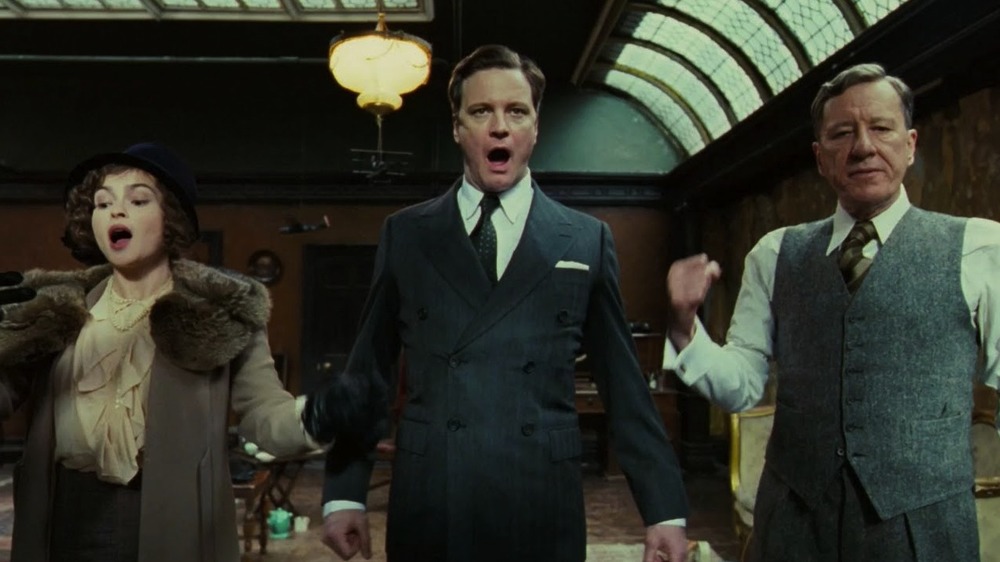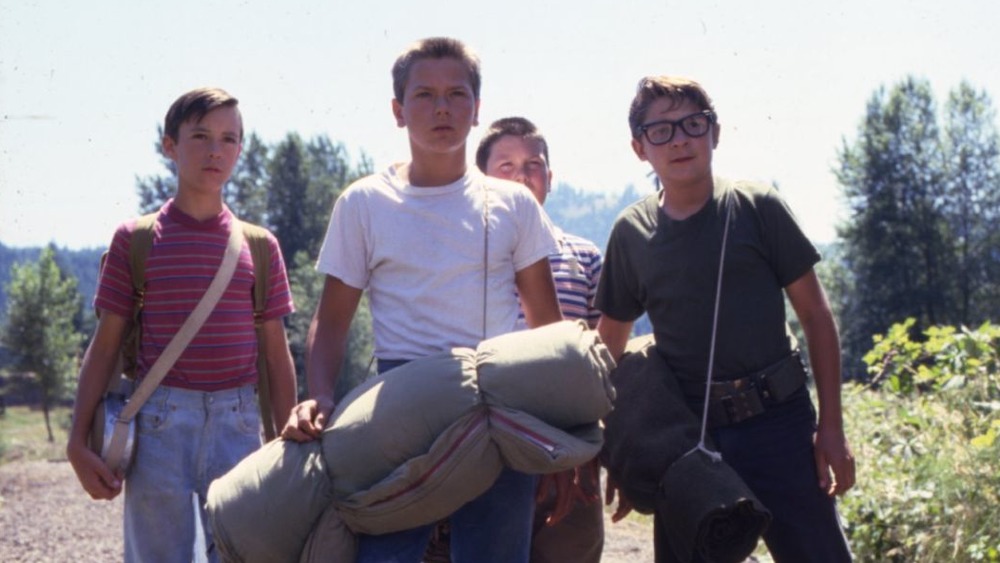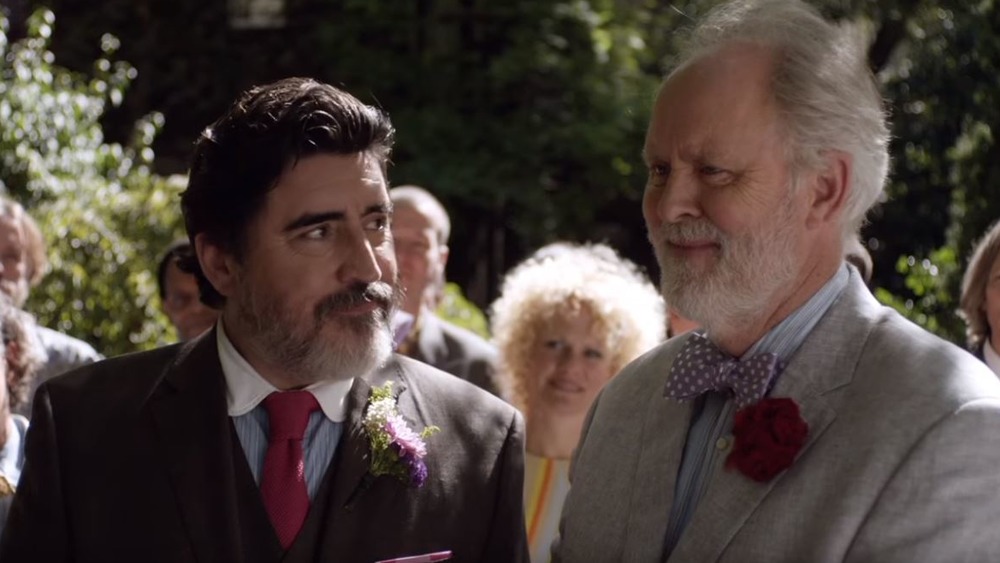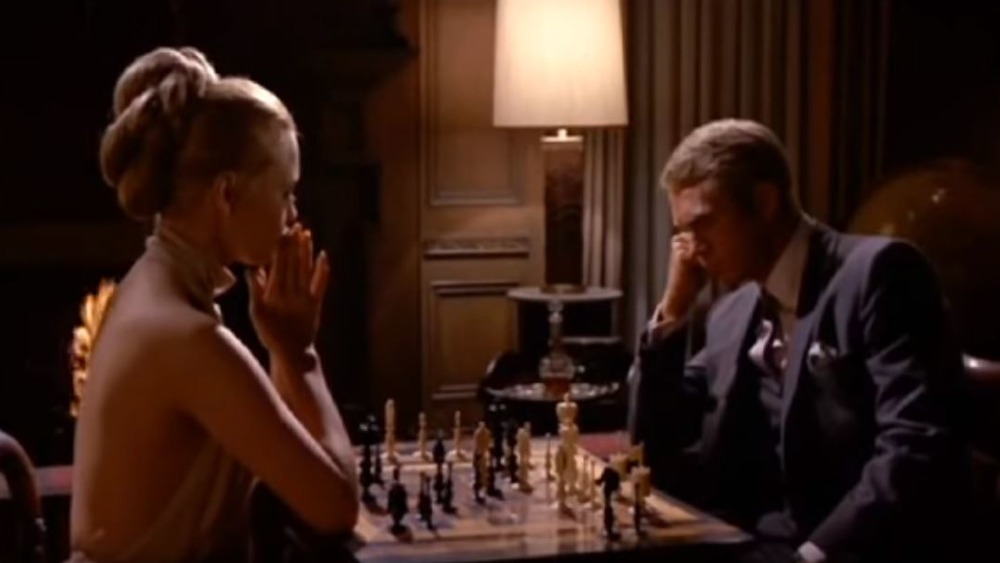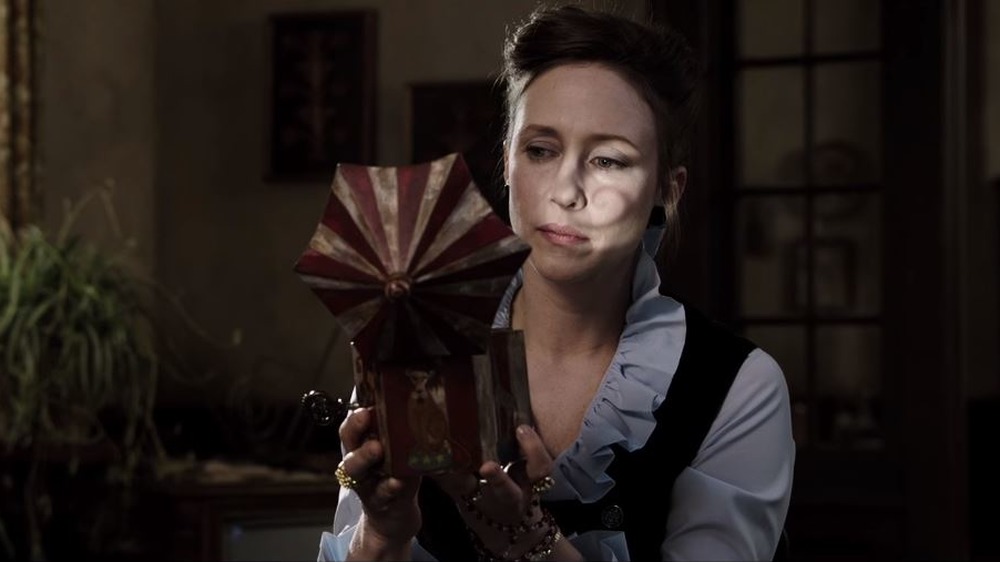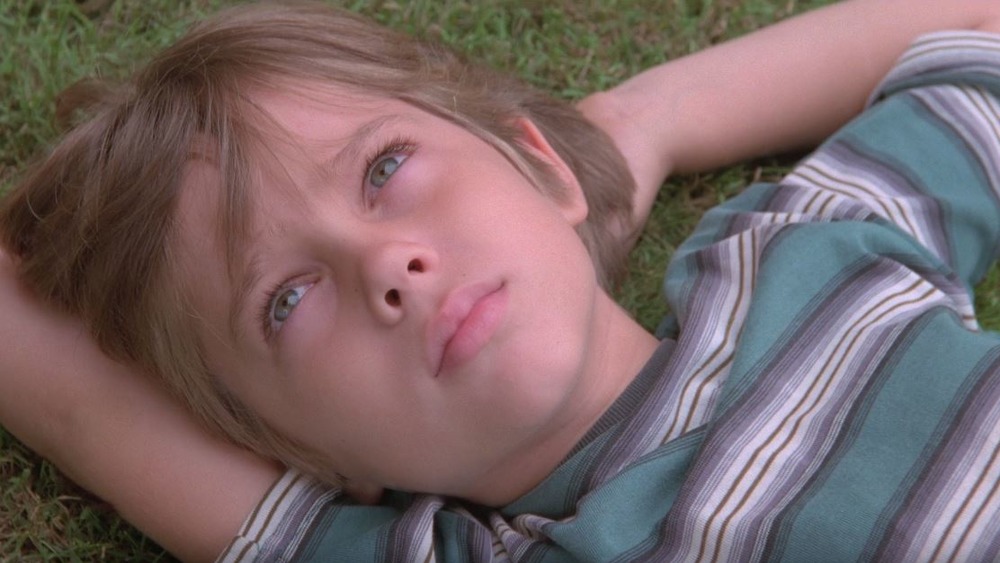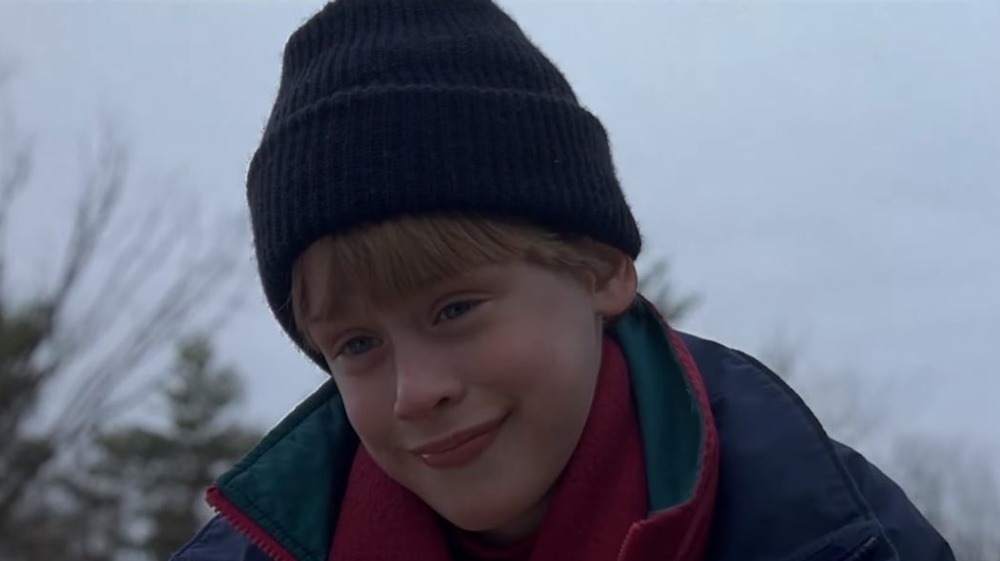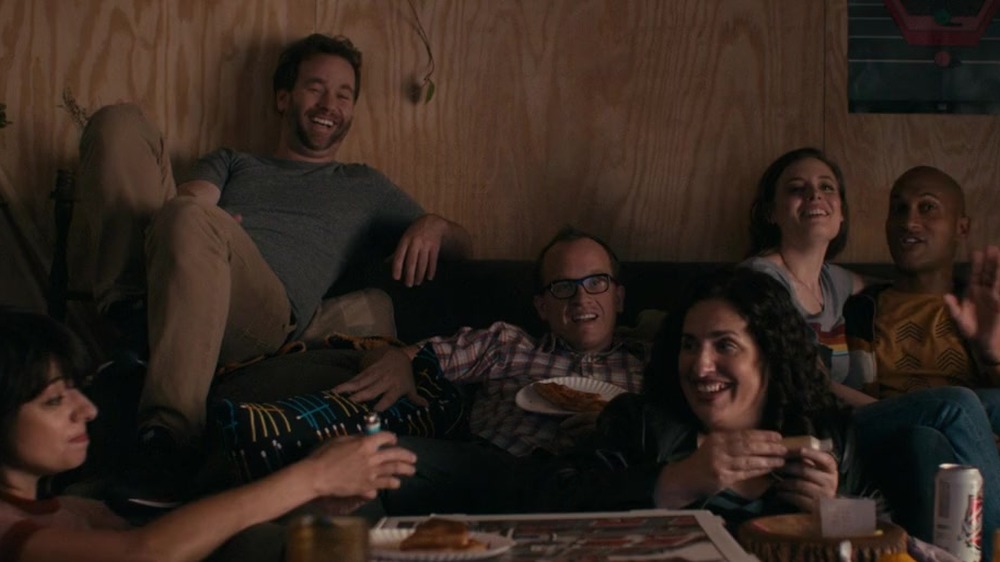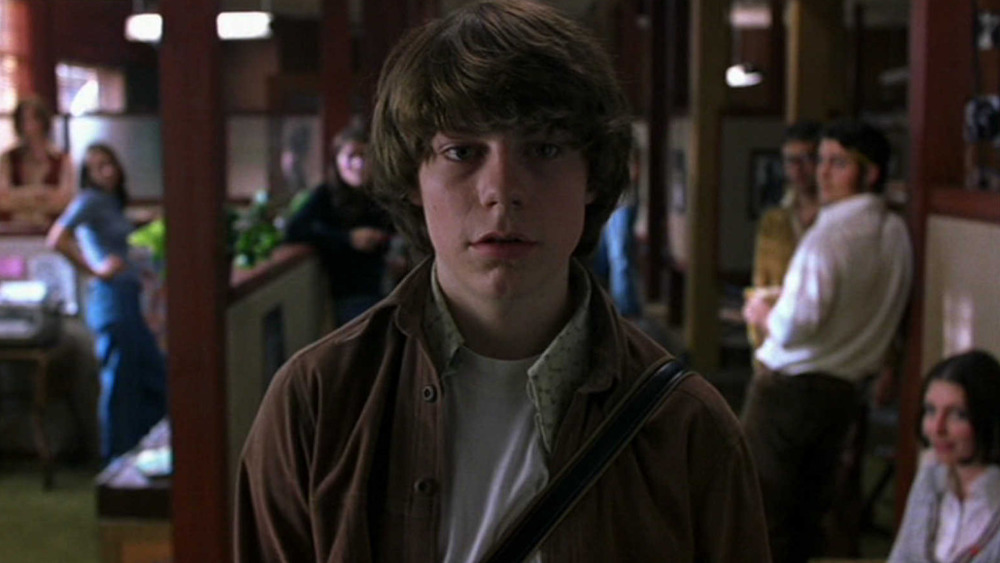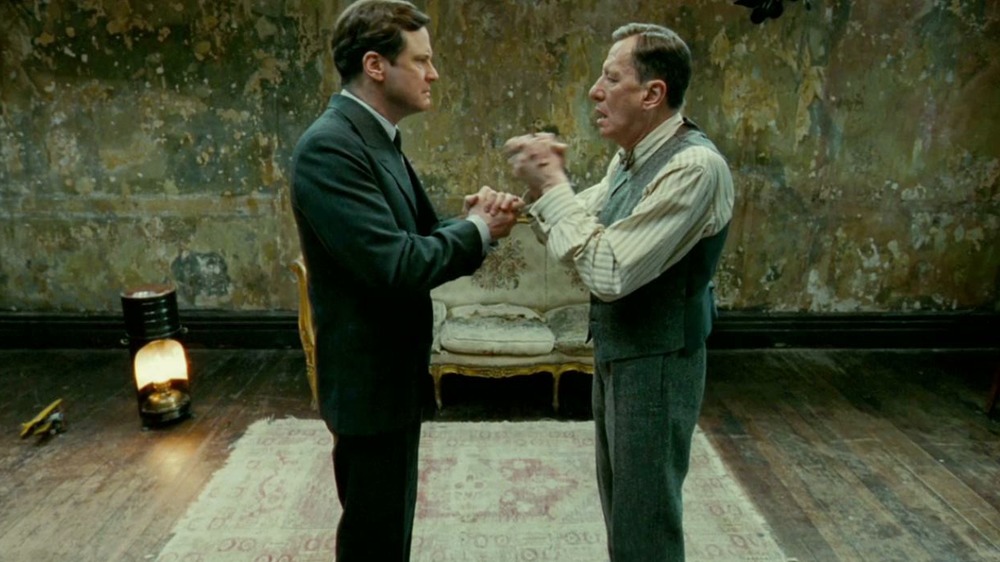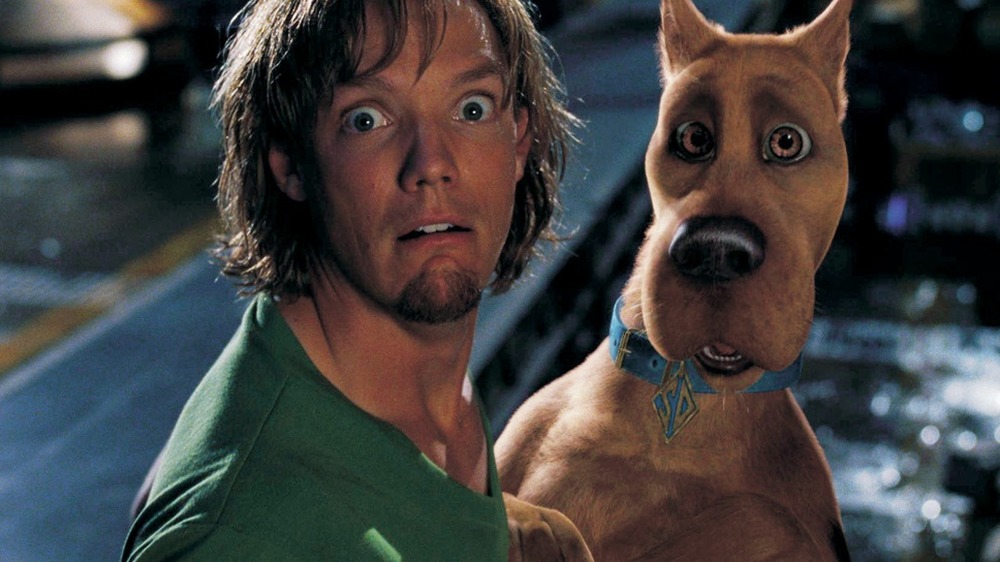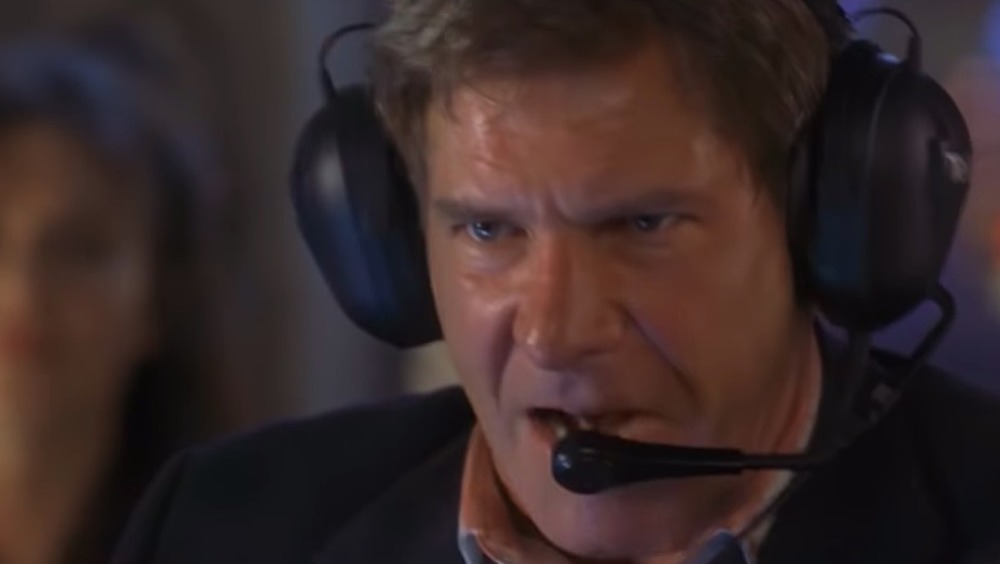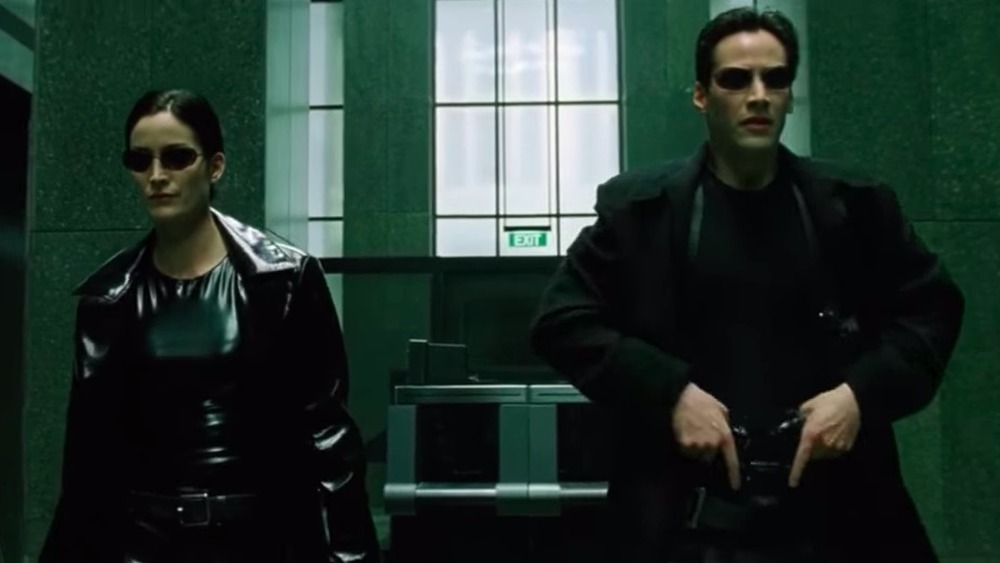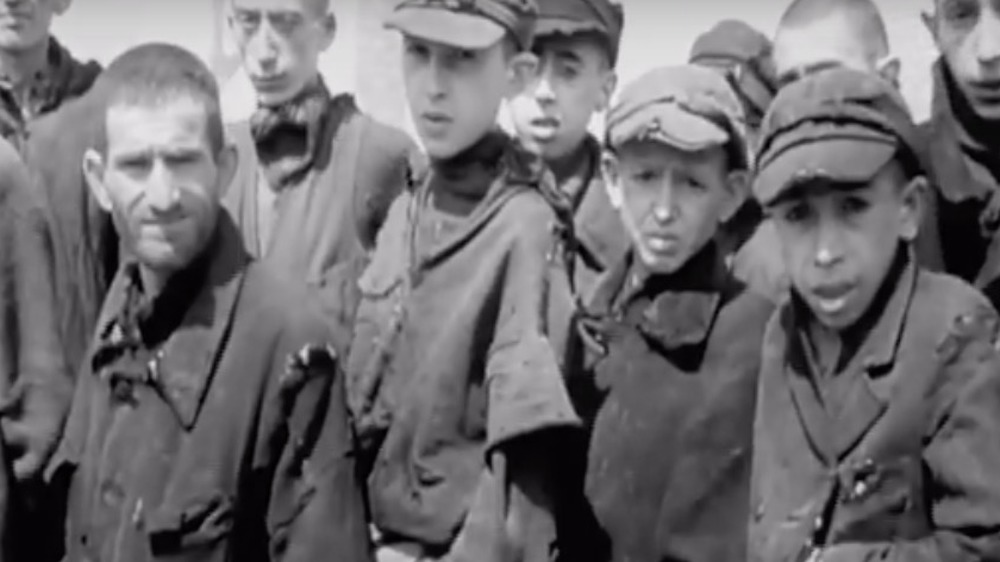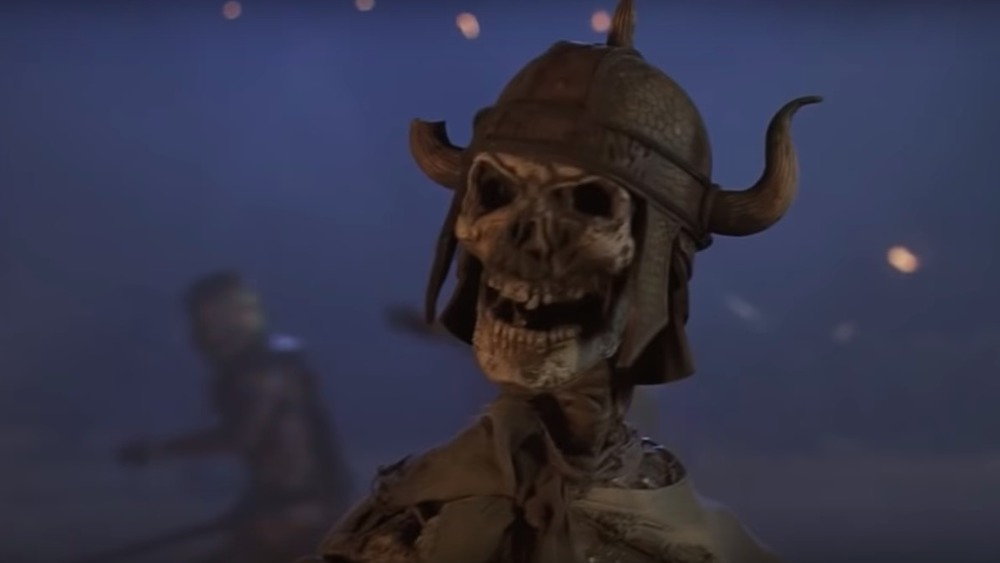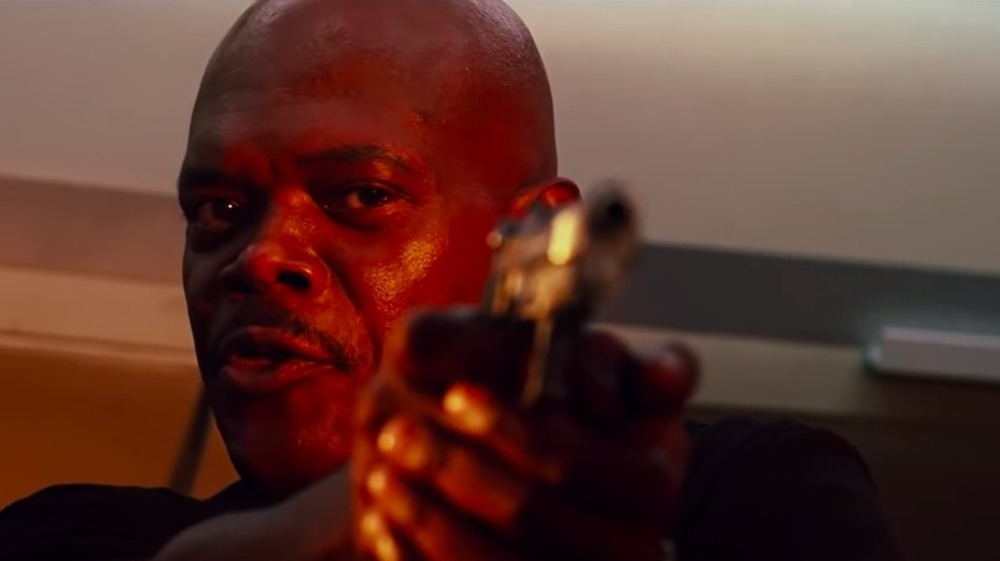Movies That Were Rated R For Very Strange Reasons
The Motion Picture Association of America has assigned ratings to almost every film that has hit the theaters of the USA since 1930. Over the years, the organization has gotten a reputation for being inconsistent, hypocritical, and puritanical, especially with films it has rated R. Here are a few movies the MPAA rated R for strange reasons.
Stand By Me (1986)
This drama about four adolescent boys in 1950s Oregon who embark on an adventure to see a dead body has become a modern classic and staple of cable television. Based on a Stephen King novella and directed by Rob Reiner, Stand By Me features breakout performances from its young cast, including Wil Wheaton, River Phoenix, Corey Feldman, and Jerry O'Connell. The coming-of-age film full of kids also occasionally has some adult language; you know, the kind kids often use as soon as their parents leave the room. This handful of F words earned the otherwise youth-friendly movie an R-rating from the MPAA, as the organization strictly adhered to codes rather than analyzed the overall content of the film.
Columbia Pictures tried to get the screenwriters to eliminate some of the language to obtain a PG rating, but they balked at the suggestion. Raynold Gideon told Yahoo, "Norman Lear said to us, 'Don't change a thing. If my life has meant anything, it's to keep artistic excellence the way it is; we don't try to compromise because of ratings.' Also, we felt that an R would make people go, 'Oh my God, I have to see that movie!'" And people did see it. Despite the R rating, Stand By Me managed a respectable $52 million at the box office. We may not have friends like the ones we had when we were 12, but these four friends have stuck with us for over 30 years.
Love Is Strange (2014)
Acclaimed by critics upon its release, Love Is Strange focuses on an older gay couple, Ben and George, who get married after 39 years of partnership. When George is fired from his Catholic school teaching job after the archdiocese learns of the same-sex wedding, the couple face financial and emotional hardships. The mild but affecting drama earned four Independent Spirit Award nominations and also a controversial R-rating for "language."
While Love is Strange has some cursing, it's hard to figure out why a film often labeled "delicate" in reviews would receive the same rating as two ultra-violent movies that opened the same weekend: Sin City: A Dame to Kill For and Jersey Shore Massacre. Many critics accused the MPAA of hypocrisy and homophobia. "No matter how discreet and clothed its depictions, Love Is Strange is apparently just too gay for a PG-13," Michael Phillips wrote in the Chicago Tribune. "There isn't another way to read the MPAA's actions." Love is strange, truth is stranger than fiction, and MPAA ratings are even stranger.
The Thomas Crown Affair (1968)
You might not think chess is particularly sexy or controversial, but you probably haven't played chess with Faye Dunaway. This stylish heist flick starring Dunaway and Steve McQueen earned an R solely for a lengthy, memorable scene featuring a game of chess. Both characters are fully clothed and neither speaks, but during one move, Dunaway's character handles a chess piece (a bishop, of course) in a subtly sexual manner for a whole five seconds. As the tension builds, the two finally kiss passionately. Yikes!
The film isn't particularly violent nor does it contain any bad language that would earn a film more than a PG rating, but there are brief scenes of not-very-revealing, from-the-back, semi-nudity. When it was released, this was enough to earn it an M rating, which was later amended to a full R. In fact, some critics were even left bored by the film. So it seems a little silly, especially by today's standards, that a game of "chess with sex," as director Norman Jewison called it in an interview with Sight and Sound magazine, between two very pretty people would warrant the same rating reserved for films with far more overt romps. Checkmate, MPAA.
The Conjuring (2013)
R ratings often hinder box office returns, and many studios push hard for PG-13 ratings that typically bring in millions more. Horror is a particularly profitable genre with a hugely loyal fan base. Combine the two things, and you're likely to rake in the cash unless the MPAA hits you with an R. After scaring audiences with his Insidious franchise, horror maestro James Wan set out to make a "true life" haunted house flick set in the 1970s about Ed and Lorraine Warren, the paranormal investigators who worked on the infamous Amityville case. The Perrons seek out the Warrens after weird things start happening in their New England farmhouse.
Despite no language, nudity, or gore, The Conjuring still received an R because, in the words of producer Walter Hamada, the MPAA felt the film was "just so scary. There are no specific scenes or tone you could take out to get it PG-13." Wan said he was aiming for a PG-13 rating, but he didn't seem to mind receiving an R, even though a lot of internet critics took the MPAA to task for it. The Conjuring whipped up more than $319 million worldwide. The R rating and the reasoning for it might have even given it a boost, honestly.
Boyhood (2014)
In 2002, director Richard Linklater started production on an untitled film he called the "life project" in his hometown of Austin, Texas. There was no script, only a vague outline. He wanted to tell the story of a boy growing up from first grade through high school graduation, but he didn't know how to film it. Then he had an idea: film a little bit each year for 12 years. The resulting movie, Boyhood, became a critical darling and a cinematic feat. As the boy ages before the audience's eyes from 6 to 19, he experiences the highs and lows of growing up, falling in love, and finding himself just like any kid. But teens couldn't easily go see Boyhood because the MPAA slapped an R on the film for "teen drug and alcohol use," aka the very stuff teens are experiencing themselves. At least one theater decided to ignore the MPAA. The IFC Center in New York City, which is owned by Boyhood's distributor IFC Films, announced it would admit younger patrons at the theater's discretion. Its website said "the film is appropriate viewing for mature adolescents." Now that's a grown-up response, MPAA.
The Good Son (1993)
There was no bigger child star in the early '90s than Macaulay Culkin. After the mega-success Home Alone, Culkin's father, who was his manager at the time, had gotten wind of a new psychological thriller about a disturbed child penned by acclaimed writer Ian McEwan. The Good Son had been languishing in development for some time with various actors and directors attached to the project but had yet to get off the ground. Culkin's father pushed for Macaulay to star in the film as part of a lucrative deal to make Home Alone 2: Lost in New York. Fox agreed, and Culkin was cast as the evil lead, forcing McEwan to completely rewrite the script before being let go from the project altogether. What could have been a creepy film comes off unintentionally campy because of Culkin's presence, yet the MPAA still gave The Good Son an R rating for "acts of violence and terror involving a disturbed child." Nearly all the violence happens offscreen, but given just how big of a star Culkin was at the time, perhaps the MPAA awarded the film its restricted rating simply to keep fellow kids from seeing their Home Alone hero go psycho.
Don't Think Twice (2016)
The MPAA's ratings often highlight inconsistencies in the organization's criteria for censoring content for younger viewers. There's no better example of that than Don't Think Twice, a bittersweet indie comedy from comedian Mike Birbiglia. The film focuses on a group of improv comedians whose relationships with each other begin fracturing after one member of the group is hired at an SNL-like TV sketch show and becomes famous. The backstage look at how comedy sausage is made received glowing reviews ... and an R rating from the MPAA. Birbiglia was rightly upset, tweeting, "Suicide Squad has machine gun killings and bombings and got a PG-13 rating. Don't Think Twice gets an R because adults smoke pot. Confusing?" Indeed the hyper-violent Suicide Squad was released the same weekend as the indie comedy, but somehow the MPAA felt Birbiglia's film was more offensive despite having only one F-word (which is permissible in PG-13 films) and adults smoking pot and having offscreen consensual sex. It's cool for kids to watch comic book antiheroes bash people bloody with baseball bats, though.
Almost Famous (2000)
On the surface, Almost Famous is a film about rock-and-roll in the 1970s, but Cameron Crowe's nostalgic look at his adolescent years as a writer for Rolling Stone is really a bittersweet coming-of-age drama with the music industry as its backdrop. After growing up in a strict household with a loving if overbearing mother, naive 15-year-old William Miller tries to navigate a freewheeling adult world he's not entirely prepared for as he tours with rock band Stillwater. There's obviously sex, drugs, and profanity present throughout the film, which is why it earned an R rating despite its fairly tame depiction of said things.
This particular R rating brought Roger Ebert to pen an infamously scathing critique of the MPAA and its moral inconsistencies. Ebert argued the film shouldn't be rated R because "the film applies values to its content." William himself never drinks or does drugs, doesn't have the pottymouth of his hero/mentor Lester Bangs, and his "deflowering" happens offscreen. He's an observer; "the Enemy," as one member of Stillwater labels him when he finds out William is a rock journalist. As Penny Lane says, William is "too sweet for rock and roll." As Ebert asked in his review of the film, "Why did they give an R rating to a movie perfect for teenagers?"
The King's Speech (2010)
Colin Firth won an Oscar for his performance as King George VI, the stammering monarch who forges a special friendship with Lionel Logue, an Australian-born speech therapist played by Geoffrey Rush. When his brother, Edward, abdicates the throne in order to marry divorcee Wallis Simpson, George is forced to take his place as King, putting even greater pressure on him to overcome his fears about public speaking. Bertie, as he's known to family and close friends, and Lionel try various methods and exercises to eliminate the stammer to no avail until they discover one NSFW technique that provides a breakthrough.
In one very funny scene, Lionel has Bertie yell the F-word repeatedly in order to overcome his mental blocks, which was enough to earn the otherwise tame and incredibly inspiring film an R-rating, annoying director Tom Hooper. "How many films can claim to use swearing for its therapeutic effect?" he asked the LA Times. Once the film won best picture at the Oscars, the Weinstein Company decided to release a PG-13 version with the curses muted to make it more family-friendly, which led to a new round of questions about the MPAA's ratings system. When even a king's speech is censored, maybe it's time for the MPAA to abdicate its moral throne.
The Scooby-Doo Movie (2002)
The 1970s cartoon Scooby-Doo may be about a gang of "meddling kids" who solve mysteries with an incomprehensible talking dog, but the 2002 live-action film adaptation nearly was for adults-only. In a lengthy Facebook post celebrating the 15th anniversary of the film, screenwriter and future Guardians of the Galaxy director James Gunn revealed the original cut of Scooby-Doo received an R-rating. "Yes, the rumors are true. ... The female stars' cleavage was CGI'd away so as not to offend." But apparently, it wasn't just the cleavage the MPAA objected to. Gunn added that he originally aimed the film at adults and that the MPAA thought a certain line "referred to oral sex." Ruh roh. Ultimately, the final cut received a more family-friendly PG rating but fairly harsh reviews. Maybe the edgier version would have been a more delicious Scooby Snack to audiences.
Because No One Knows
On top of all the usual suspects, some movies were rated R because of excessive amounts of No One Knows. Even the reviewers at Common Sense Media, which watches everything through the eyes of the world's most overprotective parents of the world's most fragile snowflakes, aren't sure why this movie got the dreaded R rating.
Air Force One, starring Harrison Ford, is the story of a badassed American president/action hero, who battles the terrorists who have infiltrated Air Force One. Besides having a really stupid premise, the film also has the requisite action hero violence, which is to be expected since a movie about terrorists taking over Air Force One would be totally boring if everyone just went, "Whatever man, have a gourmet cheeseburger and just promise not to stink up my super-cushy luxury bathroom, okay?"
"Parents need to know that violence in the film includes close-range shootings of innocent hostages, and death threats to women and an adolescent girl," said the reviewer at Common Sense Media. "There is also scattered profanity, but in general the R-rating is pretty surprising; seems the MPAA has slapped PG-13s on nastier films than this." And really, if Common Sense Media is left scratching its head, you have to wonder what kind of a bad day someone at the MPAA was having when they decided this movie was going to get the [censored] finger.
It's all just electrical signals interpreted by your brain anyway
We'll let you in on a little secret. The R rating is the world that has been pulled over your eyes to blind you from the truth: The Matrix really shouldn't have been an R-rated movie. Time to take the red pill.
Here's what Common Sense Media had to say about The Matrix: "An exciting, sometimes confusing, sci-fi adventure with a brooding Keanu Reeves and a mysterious Laurence Fishburne at its center." It then goes on to describe the weird bug-belly button scene, says there's some language, and then concludes that most kids 14 and up can probably handle the film just fine. Except it might confuse them.
So none of that sounds especially R-rating-inducing compared to some of the stuff we've seen in films like The Dark Knight, which got a PG-13 rating even though it features clown-on-clown violence, humans exploding, humans burned alive, and various other scenes of torture and violence. A little bug in the belly button really doesn't seem like such a big deal compared to that, does it?
So maybe it was the confusing part? At last check, confusing wasn't listed as a reason for an R rating, but perhaps the MPAA were like, "We don't get this so that must mean there's something really sinister hidden in there somewhere, better give it an R rating just to be on the safe side." Got any more of those blue pills?
Because nudity is way worse than violence
The MPAA's moratorium on nudity is just bizarre because it encompasses all kinds, from the actually bawdy type, to stuffthat is not really any different than what you'd see if you were looking at 200-year-old paintings in a museum, to the kind that is necessary to the story and also not even remotely risque. Basically, if there are butt cheeks or boobs, it's rated R. Context means nothing. Meanwhile, if it involves exploding people, well, it's fine so long as there isn't a ton of blood. Oh-kay.
So while the MPAA is shielding the children from the horrors of butt cheeks, it's also shielding them from stories that might teach them important lessons about morality, history, and human nature. A Film Unfinished is about Nazi propaganda, and filmmakers hoped it would be used as a teaching tool in high school classes. But alas. The MPAA rated the film R in part because of a scene in which Jewish prisoners are forced to strip naked, although it did also cite "disturbing images of Holocaust atrocities" as another reason for the rating.
In an interview with the Jewish Telegraphic Agency, the film's distributor said, "In a world where young people are bombarded with meaningless entertainment, it's unfortunate that a film with real educational and historic value would be denied to them by an organization that is supposed to be working to help them." But still. Breasts!
Think of the skeleton children
There's violence and there's cartoon violence — cartoon violence is fake and campy, like when you put one of those things on your head that makes it look like there's a dagger in your brain. Even a 4-year-old knows that's fake.
The MPAA is nothing if not inconsistent, though. It's super okay with Dark Knight violence, but campy violence like the stuff in the 1992 film Army of Darkness is just going too far.
Army of Darkness is the third, less-violent movie in the Evil Dead series. A Wired writer who wrote about watching the film with his 9- and 11-year-olds called it "as mild as any PG film." The gore is limited to stuff like fake-looking fountains of blood and humans fighting skeletons. The F word is said once, which is within the limits for a PG-13 rating, and there are a few other curse words but nothing like The King's Speech or anything, and we all know that every child who accidentally saw that one is still finishing up years of expensive therapy.
And yet, for reasons that are baffling, this movie was not only rated R, but director Sam Raimi had to fight to have it reduced to an R from the original NC-17. According to Mental Floss, the MPAA begrudgingly agreed to change the rating after Raimi pointed out they'd based their decision on human-on-skeleton violence, and skeletons don't bleed. But still, think of the children! The skeleton children.
Please give us an R rating
Of all the super bizarre reasons for R ratings, this one is probably the weirdest. Snakes on a Plane was rated R not because the MPAA had some stupid reason they pulled out of their [censored] patooties at the last second, but because filmmakers actually wanted an R rating. In fact, they wanted that R rating so badly they actually went back after the film wrapped and shot some extra scenes to make the movie more violent.
But why? According to the LA Times, the whole point of the movie was the ridiculous B-movie premise, and fans of B-movies don't want to see films that have been watered down for the kiddies. In fact, fans were so vocal about what they wanted in Snakes on a Plane that Samuel L. Jackson actually said they were a part of the "collaborative process."
According to Entertainment Weekly, the new additions included more violent snake strikes, some airplane bathroom hooking-up (with more snake strikes), and Jackson's famous "I've had it with these motherf*cking snakes" line. So did this movie, like films that have been unfairly slapped with an R rating, suffer monetarily? Maybe. It grossed just $62 million at the box office. Would a PG-13 rating have helped? Who knows. But if Snakes on a Plane had been rated PG-13, Samuel L. Jackson would never have uttered that iconic line, and does anyone truly want to live in that world?
